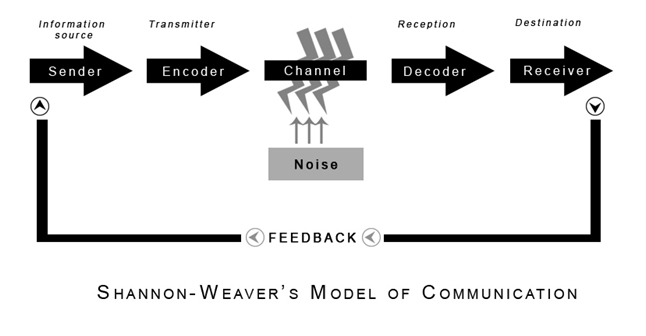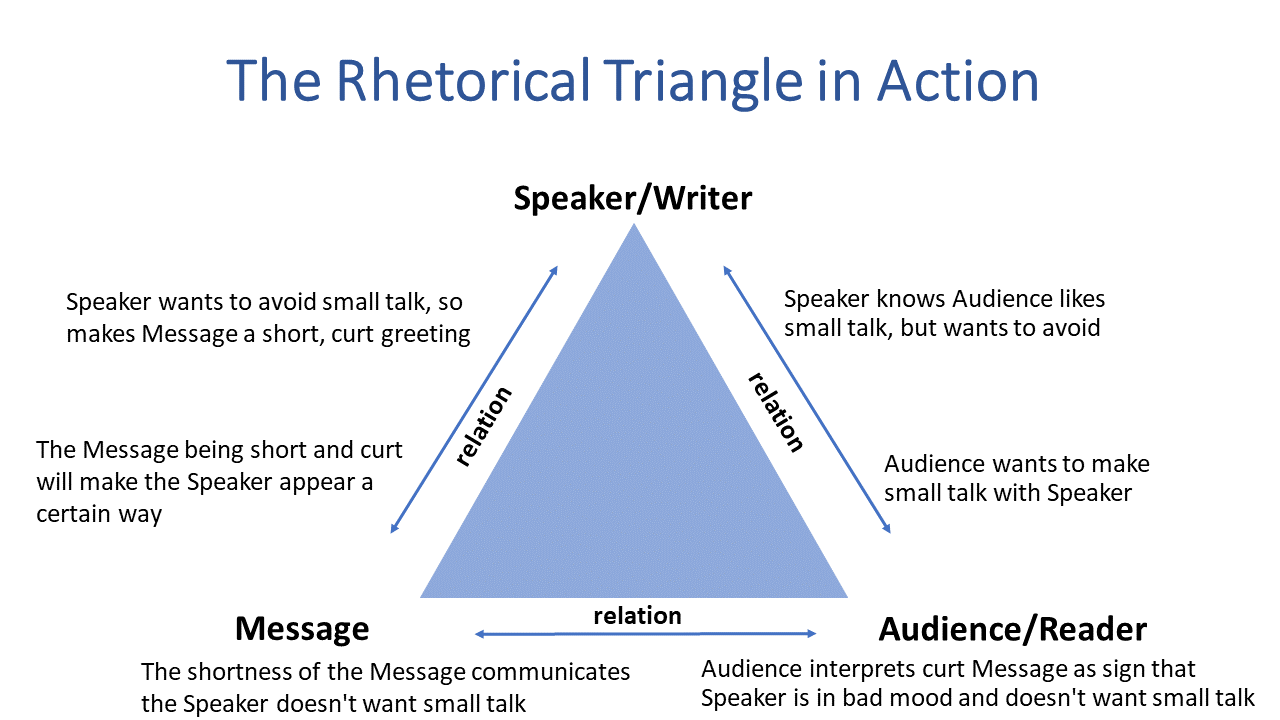1.04: Chapter 4: The Rhetorical Triangle
- Page ID
- 134470
4
Chapter 4: The Rhetorical Triangle
Rebekah Bennetch, Corey Owen, and Zachary Keesey
Learning Objectives
By the end of this chapter, you should be able to:
- Differentiate between the Shannon-Weaver model of communication and the rhetorical triangle model of communication
- Explain why the rhetorical triangle model is the preferred model for this course
Key Terms and Concepts
- Shannon-Weaver model/transmission model
- sender
- receiver
- noise
- feedback
- rhetorical triangle
The Shannon-Weaver Model of Communication
Communication textbooks often adopt the Shannon-Weaver model (1948)—also known as the transmission model—to represent the linear process of communication, as shown in the image below.

In this linear model, a sender encodes information and, through a transmitter, sends it to a receiver, who subsequently decodes the message. According to this model then, information seems to move in a simplified, linear manner, even though the process can be complicated by noise, which is information that is added unintentionally to a message during transmission, and feedback, which is information that the receiver transmits back to the sender.
The Shannon-Weaver model does have limits though. While this model of communication provided a fruitful basis for information theory—a body of theory that investigates the processes by which information is encoded and transmitted in a digital context—it is less useful when we consider human communication. In this regard, the model fails to represent the dynamic nature of interpersonal communication, which is due to the complexity of people. In other words, the Shannon-Weaver model simplistically depicts an act of communication as though information was somehow shared through a simple, linear action:
sender transmits a message -> receiver receives the message -> transmission complete!Unfortunately—perhaps—this is not how human communication works.
A “Simple” Communication Example
Consider, for instance, the simplest example of human communication: when one person greets another person. Let’s say Person A, whom we’ll refer to as “the speaker,” has a prior relationship with Person B, whom we’ll refer to as “the audience.” In this case, the nature of that relationship will likely influence the type of greeting that the speaker shares. Now, what about the speaker’s relationship to their message? What if they are uncomfortable with small talk, and feel compelled to greet the audience, even though the speaker fears that the greeting will invite small talk?
However they feel about the message, the speaker’s relationship to their message will influence the way in which their message is expressed. They may be curt in their greeting, or create ambiguity by looking away quickly if they are anxious to greet the audience.
Now, let’s turn to the audience: how will they interpret such a message? Inevitably, the audience’s understanding will depend, in part, on the nature of their relationship with the speaker and their prior experience with the sort of greeting the speaker offers.
That is just one simple example that shows just how complex it can be to analyze communication. As we will see in this course, communication can be much more intricate.
The Rhetorical Triangle
To account for the complexity of communication, RCM 200 uses a communication model known as the rhetorical triangle. Through this model, we can see that each of the elements of communication—the speaker, audience, and message—are related to each of the others, and we can understand that communication is a complex, dynamic system. The diagram below shows this.
Now, let apply this model to our “simple” communication example from earlier.

As the image above shows, there is a lot happening in this one interaction, and all of it is simultaneous!
Recognizing that communication is a dynamic process, where the relationship of the speaker, message, and audience are always impacting each other, is key to succeeding in this course.
Key Takeaways
- The Shannon-Weaver Model states that communication is a linear process where the sender encodes a message and a receiver decodes it.
- While helpful for understanding communication at basic level, the model does not account for the complexities of human communication.
- In this course, we use the rhetorical triangle model because it emphasizes that elements of communication—the speaker, audience, and message—are related to each other. This model shows that communication is much more dynamic in nature.
References
Communication Theory. (n.d.) [Diagram of Shannon-Weaver’s Model of Communication]. https://www.communicationtheory.org/shannon-and-weaver-model-of-communication/


